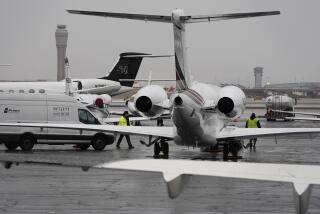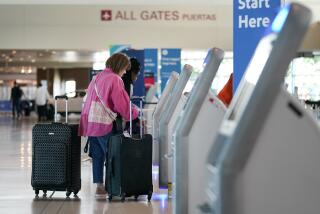Backing Air Safety Bill
- Share via
A bill has been introduced in Congress, at last, that could lead to safer air travel.
Sponsored by Rep. Norman Mineta (D-Calif.), the proposed legislation would require that the federal government use the so-called Aviation Trust Fund for its intended purpose, which is to upgrade the nation’s airports and air traffic control system.
The fund, financed by an 8% tax on every domestic ticket you and I buy, stands at $5.6 billion. And it stands, and stands, and stands . . . doing nothing.
Nothing, that is, except making the federal budget picture look a little healthier. The money is locked up in the general revenue fund and the General Accounting Office has steadfastly refused to release it for aviation improvements.
In the meantime we go on paying into it, padding the general coffers, while flying in a system in need of an overhaul.
For several years, lawmakers have been fobbed off with excuses and blank stares when they asked questions about this bloated, inactive surplus. Every time there is a near miss in the air, or a crash, we hear the old platitudes trotted out about how we have to step up our efforts in the area of air transportation safety.
Bottom Line Is Top Priority
I don’t recall any serious discussion by anybody in the government about financing such an effort out of the billions of dollars in the fund. Not as long as the budget deficit is so high. Not when the bottom line looks so much better with the money reflected in the general fund.
Mineta, chairman of the House aviation subcommittee, and his colleagues apparently have become tired of asking the questions and getting no answers. The proposed legislation (H.R. 8) would remove the aviation fund from the rest of our tax contributions and have it held in separate trust.
Mineta’s legislation, co-sponsored by Rep. John Paul Hammerschmidt (R-Ark.), would let the ticket tax fluctuate, depending on how much is spent in any given year on air traffic improvements.
Each year Congress would authorize a specific sum to be used on upgrading the system. If the amount spent by the Federal Aviation Administration was less than 90% of the authorization, and as long as the surplus remained at more than $2 billion, the tax would be cut by the same percentage as the spending shortfall, up to a maximum of 25%.
The legislation governing the aviation trust fund runs through this year, so nothing will result from Mineta’s proposal until 1988 at the earliest. By that time the surplus will be closer to $7 billion at its present rate of increase.
Dickering and Dealing
You would think that the Mineta bill would have an easy passage through Congress. After all, who can argue with the concept of improved air safety?
Would that things worked that rationally in Washington. This bill will be subject to the same dickering and backroom wheeling and dealing as are most others, no matter how worthy they may appear.
But the bipartisan support for H.R. 8 does seem to be there, so maybe it won’t be sidetracked, or emerge too adulterated to achieve its purpose. Even Mineta, though, has said his proposed legislation is no more than “a starting point” for a discussion about how to get the maximum benefit from the aviation trust fund surplus.
We can’t legislate safety. But what we can, and must, legislate is that we take advantage of everything we can to help improve the picture. In this instance, all we need to do is use the money already collected.
Nobody expects the FAA to rush out and cure our air transportation system ills overnight, even with $5.6 billion. Throwing money at the problem without a plan won’t accomplish anything--except depletion of the fund.
But $5.6 billion, properly spent, can go a long way toward taking a lot of the risk out of air travel. Since there’s a lot of my money in that trust fund, I think it’s time we used it to do just that.
More to Read
Inside the business of entertainment
The Wide Shot brings you news, analysis and insights on everything from streaming wars to production — and what it all means for the future.
You may occasionally receive promotional content from the Los Angeles Times.










